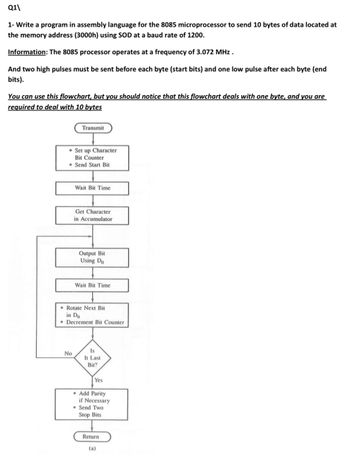
Database System Concepts
7th Edition
ISBN: 9780078022159
Author: Abraham Silberschatz Professor, Henry F. Korth, S. Sudarshan
Publisher: McGraw-Hill Education
expand_more
expand_more
format_list_bulleted
Concept explainers
Question

Transcribed Image Text:Q1\
1- Write a program in assembly language for the 8085 microprocessor to send 10 bytes of data located at
the memory address (3000h) using SOD at a baud rate of 1200.
Information: The 8085 processor operates at a frequency of 3.072 MHz.
And two high pulses must be sent before each byte (start bits) and one low pulse after each byte (end
bits).
You can use this flowchart, but you should notice that this flowchart deals with one byte, and you are
required to deal with 10 bytes
Transmit
No
Set up Character
Bit Counter
Send Start Bit
Wait Bit Time
Get Character
in Accumulator
Output Bit
Using Do
Wait Bit Time
Rotate Next Bit
in Do
Decrement Bit Counter
Is
It Last
Bit?
Yes
Add Parity
if Necessary
• Send Two
Stop Bits
Return
(a)
Expert Solution
This question has been solved!
Explore an expertly crafted, step-by-step solution for a thorough understanding of key concepts.
Step by stepSolved in 5 steps

Knowledge Booster
Learn more about
Need a deep-dive on the concept behind this application? Look no further. Learn more about this topic, computer-science and related others by exploring similar questions and additional content below.Similar questions
- Write an interactive program that inputs the coefficient of a quadratic equation, computes, and displays the roots of the quadratic equation. All input, computation, and output should be done using double-precision floating-point instructions and registers. The program should handle the case of complex roots and displays the results properly. note: the solution should be in MIPS assembly language.arrow_forwardplz do it in very easy methid in assembly languagearrow_forwardIm having trouble with this problem in writing a masm code for assembly language.arrow_forward
- I've been working on this project about an assembly-language program that prints the binary version of a four numeral decimal number (such as 3241) to the console, I finished the code but when I run it into LC-3 simulator I get his error "Oh no! You've got an error in your assembly code: at line 16: immediate field is out of range: expected value to fit in 5 bits (i.e., to be between -16 and 15, inclusive), but found 48" I tried to changed the numbers but it didn't work I just need help solving this error so it's able to run into the simulator and prints the output into the console here is the link of the simulator I'm using and my code: link: https://wchargin.com/lc3web/ Code: ;Kevin Hernandez;assembly3.asm A) BINARY TO ASCII;Lavels OPCODE OPERANDS ;Line up the columns .ORIG x3000;data sectionNUMBER .FILL #3241 ;This number is store in NUMBERBIN_REP .BLKW #16 ;This is 16-bit ;code section…arrow_forwardLadder logic program. Please answer you've done these problems before.arrow_forwardComputer Science Using memory-mapped I/O and polling, write a function print_string that prints a string onthe display, without using any system call. The address of the string is passed in register $a0and the string must be null-terminated. Test this function by calling it from the main function.Make sure to activate the “Keyboard and Display MMIO Simulator”.arrow_forward
- Please complete the following in the application "Logisim" and include input below. 1. Implement the following state diagram using the mod-4 counter as a starting point. 00 10 01 11 2. Implement a Mod-6 counter using 3 registers and a 6x3 ROM memory.arrow_forward7. Print 10, 9, 8, ... 0, using loop. a. Write the while loop pseudocode. b. Write it in MARIE's assembly language.arrow_forwardhey can you please solve this using emu 8086 Write an assembly program to display the largest of three variables. The three variables num1, num2 and num3 have values 89,20 and 56, respectively.arrow_forward
- C++ Sample Run: Enter file name: gates.txt Set 1: 1 Set 2: 0arrow_forwardConsider the following C-statement(s). Assume that the variables f, g, h, i, and jare assigned into the registers $s0, $s1, $s2, $s3, and $s4 respectively. Convert into MIPS code. Then convert to Machine Code. f = (i+h) * (j-g)arrow_forwardi. Using a flow graphic and an Intel microprocessor, briefly describe how adding two binary integers works. ii. For the flowchart above, create a pseudocode and a code in any easy assembly language. iii. To perform a reduction procedure, follow steps I and ii above.arrow_forward
arrow_back_ios
SEE MORE QUESTIONS
arrow_forward_ios
Recommended textbooks for you
 Database System ConceptsComputer ScienceISBN:9780078022159Author:Abraham Silberschatz Professor, Henry F. Korth, S. SudarshanPublisher:McGraw-Hill Education
Database System ConceptsComputer ScienceISBN:9780078022159Author:Abraham Silberschatz Professor, Henry F. Korth, S. SudarshanPublisher:McGraw-Hill Education Starting Out with Python (4th Edition)Computer ScienceISBN:9780134444321Author:Tony GaddisPublisher:PEARSON
Starting Out with Python (4th Edition)Computer ScienceISBN:9780134444321Author:Tony GaddisPublisher:PEARSON Digital Fundamentals (11th Edition)Computer ScienceISBN:9780132737968Author:Thomas L. FloydPublisher:PEARSON
Digital Fundamentals (11th Edition)Computer ScienceISBN:9780132737968Author:Thomas L. FloydPublisher:PEARSON C How to Program (8th Edition)Computer ScienceISBN:9780133976892Author:Paul J. Deitel, Harvey DeitelPublisher:PEARSON
C How to Program (8th Edition)Computer ScienceISBN:9780133976892Author:Paul J. Deitel, Harvey DeitelPublisher:PEARSON Database Systems: Design, Implementation, & Manag...Computer ScienceISBN:9781337627900Author:Carlos Coronel, Steven MorrisPublisher:Cengage Learning
Database Systems: Design, Implementation, & Manag...Computer ScienceISBN:9781337627900Author:Carlos Coronel, Steven MorrisPublisher:Cengage Learning Programmable Logic ControllersComputer ScienceISBN:9780073373843Author:Frank D. PetruzellaPublisher:McGraw-Hill Education
Programmable Logic ControllersComputer ScienceISBN:9780073373843Author:Frank D. PetruzellaPublisher:McGraw-Hill Education

Database System Concepts
Computer Science
ISBN:9780078022159
Author:Abraham Silberschatz Professor, Henry F. Korth, S. Sudarshan
Publisher:McGraw-Hill Education

Starting Out with Python (4th Edition)
Computer Science
ISBN:9780134444321
Author:Tony Gaddis
Publisher:PEARSON

Digital Fundamentals (11th Edition)
Computer Science
ISBN:9780132737968
Author:Thomas L. Floyd
Publisher:PEARSON

C How to Program (8th Edition)
Computer Science
ISBN:9780133976892
Author:Paul J. Deitel, Harvey Deitel
Publisher:PEARSON

Database Systems: Design, Implementation, & Manag...
Computer Science
ISBN:9781337627900
Author:Carlos Coronel, Steven Morris
Publisher:Cengage Learning

Programmable Logic Controllers
Computer Science
ISBN:9780073373843
Author:Frank D. Petruzella
Publisher:McGraw-Hill Education